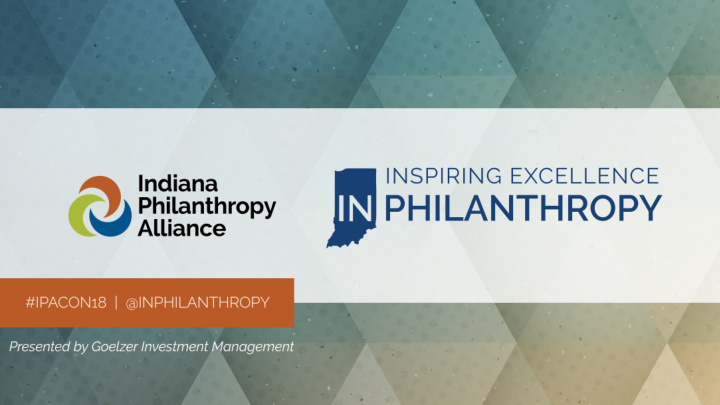



Understand Grantee Financial Statements Jenna Wachtmann, Program Officer, Ball Brothers Foundation Stephen Wachtmann, CPA/CITP/CISA, Ball State University
Does the organization appear to be “financially healthy”? • Are they thriving or barely surviving? Before • What are their major sources of revenue? • What are their major expenditures? recommending • Do they have controls in place that give me a grant, I want confidence that our grant will be well-managed? to know: • Can the organization handle its debt? • Does the organization have a “rainy day” fund?
Be familiar with key financial documents By the time you leave you Be able to spot signs of financial health will… Know how to spot red flags
Reviewing the 990 • Most nonprofit are required to file annually • Free to access Standardized form • • How it is completed provides clues for grant reviewers
» Organizational Information » Tax-exempt status » Type of organization » Changes from prior years
» Part I – Summary » Mission and significant activities » Basic organization composition » Number of board members, employees, volunteers, etc .
» Part I, Continued » Breakout of Revenues and Expenses » Total assets, liabilities and net assets
» Part IV – checklist of required schedules - look for “yes” to find potential additional information: » 10 – endowment » 11 – own land, investment activity, etc. » 12 – will indicate if the organization received an audit » 14 – overseas activity » 15 – fundraising event income
» Part VI – Governance, Management, Disclosures » Part A – Board makeup, record-keeping » 1 – # of board members, independence » 2 – relationships » 4 – changes to documents » 8 – minutes
» Part VI – Governance, Management, Disclosures » Part B – Policies » 11 – Board reviewed: » 990 » 12 – Manage conflict of interest » 15 – Compensation process
» Part VIII-Statement of Revenue » What are primary sources of revenue? » Is there a good revenue mix? Sustainable? » Tip: high reliance on government funding often requires strong cash flow!
» Part IX-Statement of Functional Expenses » What are primary expenditures? » Program expenditure vs. management vs. fundraising? » Is organization spending on vital operational needs (insurance, accounting, etc)?
» Part X, XI-Balance Sheet, Reconciliation » How much cash/short-term investments on hand? » How much debt? Mortgage? *Remember: this is only a point in time!
Balance Sheet • AKA “Statement of Financial Position” • Point in time • Asset types • Liabilities • Net assets
Assets • Listed order of decreasing liquidity Cash Receivables Longer-term (fixed) assets Liabilities (debt) • Listed order of what is due first Accounts payable Accrued expenses Other payables Long-term liabilities Net Assets Unrestricted Temp restricted Perm restricted
» Are cash and short-term investments enough to cover a few months of expenses? » Are assets increasing or decreasing from previous years? » Are receivables being collected? Is a lot owed to the What to look organization…and why? for on Balance » What kind of debt does the organization have? Is it increasing or Sheet decreasing from previous years? » How much is available in unrestricted net assets? » What are the restricted net assets?
Statement of Activities • AKA “Income Statement,” “Profit & Loss,” “Statement of Net Revenue” Over period of time • • Income/expenses over certain period of time
Shows how revenue is generated and shows ability to cover expenses Support • How diverse are support types? How much is restricted? • Revenues • How is revenue earned? Expenses • Program services vs. support services Cost to operate programs? Cost for management? Cost for fundraising? Net Assets • Ties directly to Balance Sheet
Total Support and Revenue Total Expenses Gain or (loss) • Look for trends rather than one year only • Remember, grants awarded in one year, “booked,” and spent in another can impact this calculation!
Current Assets Annual Expenses / 12 # of months of expenses that can be covered by available current assets
Audit »Auditors evaluate an organization’s finances and financial systems »The audit is accompanied by a management letter that describes deficiencies in internal controls. You can ask for this. »Nonprofits receiving $750,000 or more in federal funding are required to have an “A-133” audit
Budget Formats…Many Variations Sample Documents from Grantspace (Foundation Center)
Grant Budget Checklist Do budgeted items match narrative? Are line items clearly labeled? Are line items: Reasonable Proportionate Appropriate for foundation support? Is budget missing line items critical to success?
Reading Financial Documents Bottom Line »Do not be afraid because you are not a “numbers person.” »Do not be afraid to ask questions . »Do not try to do the job of an accountant . »Do let the financial statements tell you part of the organization’s story.
Recommend
More recommend